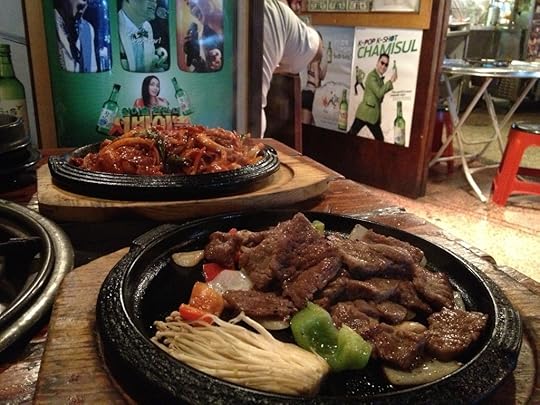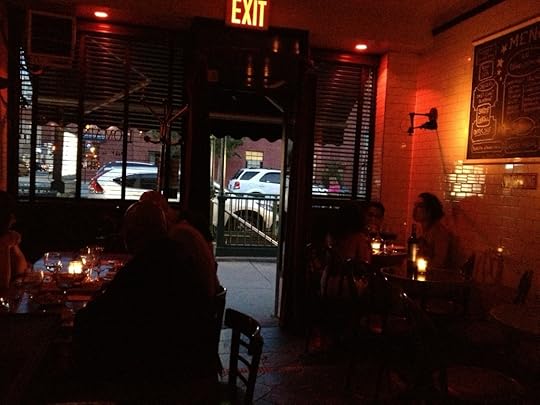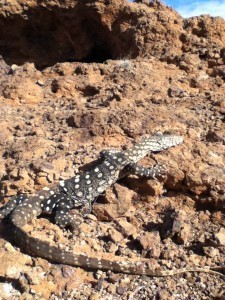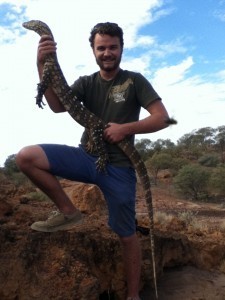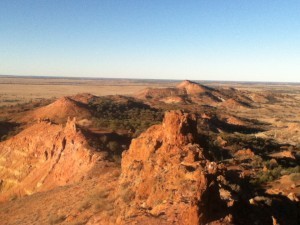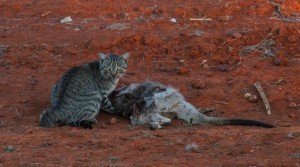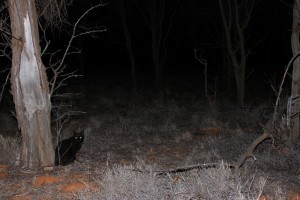Lisa Niver's Blog: We Said Go Travel, page 469
September 5, 2013
Going Deep in Queens 2 – Citi Field, Sik Gaek, and Domaine
In the first installment of this two-parter, Chih-Yu and I had begun a day-long mini-odyssey across the borough of Queens via the 7 train, armed with only a credit card and an adolescent sense-of-adventure. To catch you up in-a-hurry, Queens is home to the Mets, and also a vast, mysterious patchwork of neighborhoods, home to people from a multitude of different cultural backgrounds, many – luckily – with amazing food. In the morning, we visited one of Flushing’s premier dim sum banquet halls, and stopped into a small tea shop that’s a branch of a Taiwanese treasure.
Now it’s midday, and we’re headed to Citi Field.
Citi Field

Photo by Takahiro Nagao
It’s hard to find anything negative to say about the Mets’ shiny new home. It’s infinitely more classy than the monolithic new Yankees stadium (though try convincing a Yankees fan of that). It looks like a ball-park-of-old, with its regal red brick exterior and sexy archways. Bleachers in the outfield, instead of soccer-stadium-style encirclement, allow a great view out the sides. It sits on a dramatic patch of land as well, with Corona Park and the Arthur Ashe Tennis Center to the south, the ruggedness of a junkyard, with Flushing just beyond, to the East, and LaGuardia and the Bay to the north. All that’s visible from the bleachers. But skin-deep is where the resemblance to old-school ball-parks ends. Get inside, and Citi’s more like a luxury shopping mall that incidentally contains a ball game. Giant escalators carry you effortlessly from the lobby to the upper decks, where you’ll find wide, ergonomic corridors and easy-to-access seats, all with an amazing view. Slip out to one of the promenades and you’ll find microbrews, Shake Shack, Two Boots Pizza, Blue Smoke Barbecue, and, yes, a metric ton of Nathan’s Famous Hot Dog stands, many of them on open-air plazas with sweeping views.
This is not your father’s ball park.
It’s hard to find anything negative to say, but maybe we’re losing the spirit of the game just a bit by making it “too easy” to enjoy. Every creature comfort is satisfied, and the feel of the place is rather corporate. Huge HD screens play the “let’s go” music between at-bats, and a few members of the crows half-heartedly follow along. This is a far cry from the Hanshin Tigers of Osaka, where fans with matching noise-makers pack into the cramped bleachers elbow-to-elbow, cheer together, and nobody leaves until it’s over. It’s more like visiting a museum. But this is the new age of baseball – convenient, gourmet, low-impact.
Luckily the rest of our day takes us deeper. Ten minutes toward Manhattan on the 7 train is Sik Gaek.
Sik Gaek
49-11 Roosevelt Ave
Woodside, NY 11377
A picture is worth a thousand words, and the cartoonish visage of Psy – the Korean rapper whose song still creeps into my head if I’m not careful – shilling for Soju on one of the hundreds of posters on the wall, while heaping plates of barbecued beef and pork sizzle in the foreground, says about all you need to know about Sik Gaek. The windows are boarded up, deliberately, and the entire place is painted black. From outside, it more closely resembles a strip club than a barbecue joint. You enter to a chorus of “hellos” in Korean. (At least that’s what I assume they’re saying.) A crack team of waiters outfitted with secret-service earpieces executes a well-choreographed ballet with ludicrously-sized hot platters of food, dodging clients by just inches as they dart from kitchen to table and back.
The floor, booths, and tables are all polished wood, and thousands of dollar bills adhere to the walls. In the center of every table is a twelve-inch diameter gas grill. The first thing they do when you take your seat is fire up the grill and fry an egg. It does the trick, taking the “edge” off the hunger. Chih-Yu and I sample mostly from the “turf” category (no live octopus on this trip, though it gives us an excuse for a return journey), though a savory, melt-in-your-mouth mackerel manages to sneak its way in. Robust beef short ribs are delicious any way, but best wrapped in lettuce. The pork is grilled with kimchi, and tastes sweet, spicy, and fatty in just the right proportions. Instead of rice, we have a macabre-looking bowl of rice cakes in red pepper sauce. Sik Gaek is exceptional even for a neighborhood known for great Korean food, which, I argue, ranks it among the best restaurants in New York.

Photo by Graham Hills
Soju, the most recognizable varietal of Korean hooch, is an integral part of the Sik Gaek experience. After years of watching Korean shows on basic cable (it’s better than CNN), I became obsessed with soju. What is this delicious beverage everyone’s slogging-down by the bottle-full as they nosh barbecue on the side of the road at 3am in the winter? Did it taste sweet and aromatic, like sake, or pungent and stiff, like Japanese shochu (with which soju should never be confused. They should be pretty easy to keep straight, right?) I finally tracked down a bottle of the stuff at an H-Mart, chilled it, and cracked it open to discover it tasted like…watery vodka.
Like every acquired taste, soju grew on me. The Russians were onto something with vodka, a perfect counterpoint to spicy food and cold weather. Now imagine a lighter version. Confronted with mountains of roasted meat, it’s hard to imagine saving room for beer, but soju goes down easy. I’ve also invented a rule-of-thumb – the prettier the model advertising it, the less likely it is to be good. (Though practically everybody is advertising Jinro – kind of the Budweiser of Korea.) The female models, pop-stars, and actors tend to hawk the sweet stuff, which contains high fructose corn syrup. I like to keep it simple. Which makes Psy pretty much the perfect spokesman.
Domaine Bar a Vins
50-04 Vernon Blvd
Long Island City, NY 11101
From the frenetic energy of Queens Boulevard in Woodside, beneath the 7 train tracks, we transition to the more staid Long Island City. It wasn’t always this way. When I first moved to the city in 2001, Long Island City was the place locals told you not to get lost, especially with large denominations of cash on you. Twelve years hence, and high rise condos you-can’t-afford are sprouting like mushrooms, and LIC is kind of the bedroom community for the UN and banking district just across the river.
Somehow it’s retained some of the old “punk” flavor, though. The new-construction units mostly just grabbed up the waterfront property at Gantry Plaza, blocking-the-view-of – but not razing – the pre-existing vinyl-sided and brick buildings that are home to the neighborhood’s mainstays. Case-in-point: Domaine Bar a Vins, which despite its name being in French, is about the least pretentious wine bar you can imagine. It’s got tile walls like a speakeasy. Depending on who’s tending bar, you might hear Bob Marley, Johnny Cash, or Billie Holiday blasting from the speakers. There’s not a stick of mahogany to be found, and the clientele gives the place the feel of an off-the-beaten path nabe joint, not a foo-foo tourist destination.
It’s worlds away from Flushing, the Mets, and Sik Gaek, and that makes it the appropriate spot to cap off the night with a couple of glasses of reisling and a small plate of oysters.
Now, of course, the neighborhood is the perfect place to “get lost”, strolling its foggy back-corners and nursing a mean wine buzz. You’ve been around the world in grand style, and you haven’t even left Queens.
The post Going Deep in Queens 2 – Citi Field, Sik Gaek, and Domaine appeared first on We Said Go Travel.
Australia: Heading West – Perentie
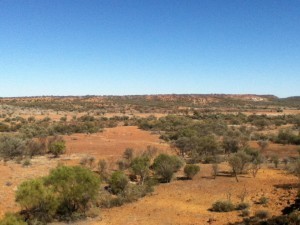
Part 3: Heading West – Perentie
After two hours sleep, another hour or so nursing our wounds from being lost for a night in the bush and a couple sandwiches, we were ready to continue our Perentie search in earnest. Dust filtered on the breeze and through the short trees, landing on the red rocks and equally red soil. It was quiet save for the loose rocks clicking together underfoot, and the Whistling Kites which seemed to be reprimanding these two intruders with their sharp calls. It was hard to imagine anything thriving in such an environment, let alone the fourth largest lizard in the world.
The morning was already stifling, nearly 85 F in the dead of winter. A warm breeze curled its way around the unexplored side of the escarpments, around immense boulders and out to the horizon, rattling the dry spinifex grasses as it did. Lockie and I poured ourselves into every cave and crevice, crawling into spaces barely big enough to fit, all-the-while reading the landscape for signs of the mighty lizard.
I pulled my head from a cave to hear Lockie’s voice ring out, “You might want to come take a look at this!” There was excitement in his voice. I raced down the escarpment’s edge as fast as the unstable ground would allow. As I climbed a nearby mesa, I could see Lockie’s twitching movements. He pointed to a small hole; its entrance was smooth sand. It was extraordinarily unobtrusive and I may have even over looked it had it not been for a small portion of thick yellow tail sticking out of one side.
The Perentie was enormous and hissed intimidatingly as we gingerly poked our heads in the hole for a closer look. After a few moments of gentle coaxing, the massive lizard emerged into the daylight. Lockie carefully picked it up for a closer look, the Perentie dwarfed him. We judged it to be a large female based on the lack of hemipenes. She had creamy spots in horizontal rows across her back and continued down much of her tail. The last third of her exceptionally long tail was cream colored. Three deep scars from an old injury graced the base of the Perentie’s tail. Her neck was exceptionally long and snake-like, her chin was the same creamy-yellow color as the spots on her back and patterned with black reticulations. Her eyes were yellowed and held an intelligent gaze and her long, forked tongue flicked nonchalantly in and out. Robust, powerful limbs ended in huge, sharp black claws.
Lockie and I looked at one another, absolutely enraptured by the dinosaur in his hands. Monitor lizards, or “Goannas” as they’re known in Australia, are a holdover, dating back 60 million years and are found on only three continents: Asia, Africa, and Australia. Australia is home to the highest concentration of monitors in the world containing twenty-seven species. Goannas cover a great dichotomy of sizes from the ten-foot long Komodo Dragon to the nine-inch Short-tailed Pygmy Monitor yet maintain a very similar body type. They inhabit rainforest canopies, harsh deserts, coastal wetlands and everything in between and are one of the most adaptive, successful genus of animals on the planet.
I had been enthralled with monitors for quite some time but my love multiplied exponentially when I saw my first wild goanna, a large Lace Monitor, in a national park soon after arriving in Australia. The Perentie we had managed to find that day was the apotheosis of a monitor lizard, she was, quite literally, the queen of all she surveyed. There was very little in the Australian outback game enough to tangle with a full-grown Perentie and her demeanor showed us that fact.
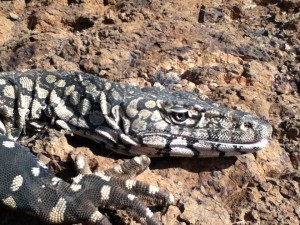
She sat on a rock in the midday sun and allowed us to photograph her for some time without the slightest hint of fear or discomfort. My shirt clung to my sweaty skin as a breeze blew across the great expanse of rocky wilderness; flies incessantly buzzed about my face, occasionally landing on my mouth or in my eyes. I occasionally swatted at them, a fairly pointless act, and they would soon regroup into their buzzing hoard. But in that moment I couldn’t have cared less because before me laid an immense lizard, the fruit of many hours of searching.
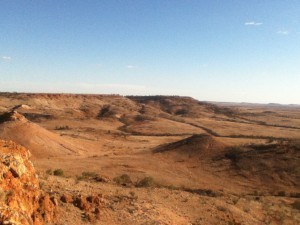
We carefully placed her back into the crack we had found her, thanking her profusely for allowing us to find her and headed back to the ute for the next leg of our journey. We sat in the cab, sucking down water, encompassed in elation and congratulating one another on the find. My hands were still shaking from the rush of adrenaline. The ute rumbled to life and we headed west on the narrow highway.
Click here to read more from Hunter including the rest of this series.
The post Australia: Heading West – Perentie appeared first on We Said Go Travel.
September 4, 2013
Brazil: Fishing for Piranhas
The jungle is alive with the choir of singing bugs. While floating our way down The Paraguay River on a boat in The Pantanal in southern Brazil, our guide, Pedro informs us that most of the time the choir of cicadas, katydids and crickets is almost deafening to the point that yelling to each other is almost a necessity. The hotter it gets, the faster and louder they sing. The stench of the alligators that litter the river as well as the banks is so overwhelming that our guide hands out a menthol creme to rub under our noses to mask the malodour. It is almost intolerable to keep my shirt on as the sweat and humidity inundate my already soaked torso. I know that if I do take off my shirt, the mosquitos that swarm all around us will eat me alive. Our boat is sputtering upstream so slowly that it doesn’t even create a breeze to help with the heat and humidity. Salty sweat from my forehead constantly trickles down into my stinging eyes. No matter how much I wipe my forehead, there is plenty of sweat to replace it. My hat I was wearing didn’t even put a dent in how much I was sweating.
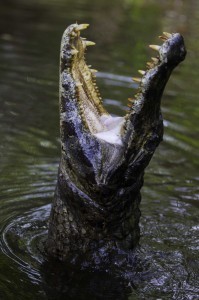
After twenty minutes putting downstream, we had finally reached our destination. My wife, me and four or five tourists disembarked from the boat and waited for Pedro on the shore of the river. When he emerged from the back, fishing poles filled his arms. After disembarking, he each handed us a bamboo fishing pole. Unlike a traditional fishing poles that had a casting system, reel and made out of a lightweight material, these poles were nothing but a stocky bamboo stick with a body’s length of fishing line tied to the end. Instead of a hook at the end of the line, there was a foot of steel wire that was tied to the end. Attached to the end of the steel line was the hook. Pedro explained that they had to do this, otherwise the piranhas would simply bite through the line and take off with the beef bait. After explaining the fishing poles, Pedro gave us a few hints so we could live to tell our story of our fishing trip without any missing body parts.
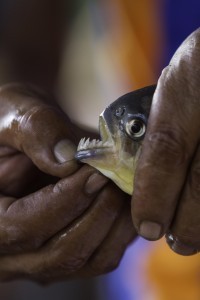
“First of all, when you catch a fish, do not reach into the water to pick it up! All you need to do is call me over when you have a piranha on your line and I will come to help you out.”
He continued to explain that this was to prevent us from accidentally sticking our finger in the vicinity of the piranha’s mouth and getting our finger bitten off.
“Second, do not go into the water! If you have any cuts or lesions on your body, the piranhas will attack you.”
Piranhas are attracted to blood and anybody with a cut on their body would be a target for the piranhas to attack.
“Finally, watch out for alligators!”
As we had passed many alligators in the water, I supposed that it was a possibility that they might watch us from a distance, or try to eat our bait in the water.
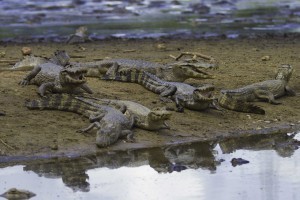
With that, he gave us each a half pound or so of beef that we would use for bait. After I had strolled upstream about twenty feet from everybody else, I baited my hook by tearing off a small slice of beef off the main chunk that was given to me and flung it into the water. In what seemed like the same amount of time it takes lightening to strike the ground , the bait was annihilated. The piranhas had devoured my bait in the same fashion a swarm of killer bees would attack a thief stealing their honey. Absolutely astonished, I froze in place, amazed. My eyes semi-bugging out, jaw halfway down I thought, “Glad I’m not their enemy!” I re-baited my hook and tossed it back in the water a few times, all the while amazed at the ferocity of the piranhas.
In a flick of a switch, a refreshing and much needed zephyr started whiffing across the river and was just enough to make me close my eyes to enjoy it for a minute or two. I put my fishing pole down and sat on the bank. My sweat drenched shirt seemed to momentarily evaporate off me. After a few minutes I had drifted off into a nap.
“Whatever you do, do not turn around.” My wife cautiously but calmly whispered to me from a few yards away, safely behind a tree along the bank. Of course, the first thing I did was turn around. My eyes still blurry from sleep, I quickly surveyed my surroundings and not seeing anything, I turned back around and looked at her, confused. She then pointed about five feet to the left of me, on the bank of the river. I warily peeked out of the corner of my eye for a few seconds before meticulously turning my head to my left. A wave of adrenaline flooded my senses as I sharply gasped. I tried swallowing but my throat had become as dry as the Sahara Desert on a scorching day. During some point when I was resting, enjoying the breeze to now, an alligator had somehow slithered out of the water undetected and decided it would be good if he just sat next to me. After pausing for a few seconds to compose my self, I cautiously stood up, all the time staring at the alligator, making sure it wasn’t going to move. His emotionless reptilian eyes glared unrelentlessly at me as though he could almost taste my flesh. He appeared to be staring me down with his dagger-filled grin, beaming in anticipation of his next meal.
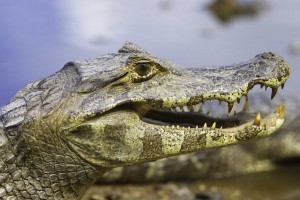
By now my wife had tip toed over to Pedro, careful not to draw the alligator’s attention to herself. From the corner of my eye, I caught a peep that Pedro noticed what was going on. He chuckled under his breath, took a quick drag off his cigarette and nonchalantly trotted over. He half-heartedly assured me that the alligators believe we are too big and won’t attack us. By the look he was radiating, I could tell he must have seen this a hundred times!
“Just start fishing, they will leave you alone. Don’t worry about it. You’re fine!”
Still walking towards me, he started to waiving his right hand in a shooing motion and shouting at the beast. Within seconds, it was gone.
“See! Nothing to worry about!”
At that, I picked up my rod and started to fish again. This time, keeping my eye on the horizon.
Over the next ten minutes of fishing, that same alligator lifelessly floated back, and decided that it was going to hang out by my side…again. I thought to myself, “Maybe I’m in his territory and this is his hangout spot. I am intruding on him, or maybe he just wants something to eat!” I continued fishing, all the while the alligator staring me down with that menacing grin. After finally landing a piranha, I carefully handled the fish the same way I saw Pedro handling the other fish. Tediously de-hooking it, I threw the piranha in the direction of the alligator. To my bemusement, he caught it mid air, took one big bite and swallowed the piranha whole. He then did something I thought only humans did; he winked at me, almost as if to say thank you for his meal.
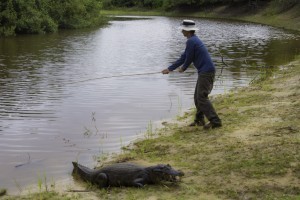
The revitalising breeze ceased as I groaned at the thought of my shirt uncomfortably bonding to my skin. With the breeze coming to a stop, our group decided that we had had enough for the day and embarked the boat. I waived to my new friend and spent the next twenty minutes in the boat imagining what might have happened if that alligator decided that he wanted me for his next meal.
The post Brazil: Fishing for Piranhas appeared first on We Said Go Travel.
Udaipur: Changing the World One Bottle at a Time
Thank you to Charu at the Butterfly Diary for publishing my article about India: “Raft Building on theBanks of the Lake Palace, Udaipur: Changing the World One Bottle at a Time.” I thought sharing this piece on backpackers changing the world was a good fit for Rosh Hashannah, the beginning of the Jewish New Year and High Holy Days.
After meandering in Asia over the last seven months on sabbatical, we began to discern one of the most noticeable consistencies of the region: the piles of plastic one-liter bottles littered across the landscape. The twin problems of absence of access to clean drinking water and lack of recycling or a plan to deal with trash are noticeable in nearly every country in Asia. At home in Los Angeles, the recycling trucks appear with frequency to transport the garbage away. However having been to the largest landfill on the planet, I know that piles of plastic continue to mount in the United States as well.
Innovators are creating biodegradable plastic and clothing made from recycled bottles. Others carry UV filters and metal canteens while traveling to reduce the consumption of plastic. In Udaipur, a veritable G-8 of travelers created community for themselves and the local children while turning trash into movable art and transport.
Isaac, the French-born Israeli fresh from the army, and Assaf, the sabra, have been biking across India. After a dangerous encounter with a truck that required Isaac to nearly rebuild the bike MacGyver style with a few paperclips and some duck tape, they had a few days rest on the roof of their Guest House in Udaipur. Noticing the pile of plastic and ready for the next engineering feat, the duo set out to construct a raft to sail the waters around the Lake Palace.
Their new friends, Katie and Erika from the Northwest of the United States, Kristen, the South African Brit, and Yanira, the Balinese Italian, were ready for the challenge. Their self-proclaimed task was to build a better boat than Team Israel.
Click here to read the full article.
The post Udaipur: Changing the World One Bottle at a Time appeared first on We Said Go Travel.
Australia: Meeting the Min Min Lights
There was no one for at least 50 kilometers in any direction; Lockie, and I had searched the entire day for a Perentie. We didn’t find anything during day but that evening, after supper, we decided to check part of the escarpment we had missed. It was the middle of winter and temperatures drop to 35-40 F at night so Perenties would usually find refuge from the cold in caves and burrows. There would also be some incredible creatures we could potentially find at night. We left camp around 5 PM with sun just starting to set.
We found two species of gecko, a snake skeleton and a King Brown snake shed skin, but no Perentie. Night eventually took hold and by 8 PM we decided to head back to camp. I followed Lockie as we made our way back, but suddenly he turned around and asked if we were going the correct way…I had lost all sense of direction.
We took a short break at an enormous rock. After 5 minutes or so a car passed along the horizon, close to 2 kilometers away. We set out for the road in an attempt to make a fresh start. When we found the road we assumed it would be a fairly straight forward walk to return to the ute and our camp but we soon realized that we were again on the wrong path.
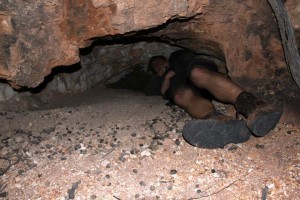
Suddenly and quite out of nowhere we saw a bright orange light through the trees. I thought, as soon as we saw it, it looked extremely odd. It resembled the beam of a flashlight and seemed to respond when we flashed ours. We assumed it was the owner of the property so we began to walk towards it in the hope of rescue. Although the light looked as though it moved forward and up and down hills and around trees, it never actually made it any closer to us. After a half hour or so of walking towards it without gaining ground we decided it couldn’t be the land owner.
We again set out for the road and when we found it we broke down our desperate search military style. Lockie remained on the top of the escarpment, no more than 50 meters away and I stayed at the bottom. We shouted back and forth at intervals announcing that we still had the ridgeline because we knew that camp was along that ridge somewhere.
It was all to no avail. I rejoined him at the top of the ridge and admitted we had better start looking for a cave to sleep in. Our flashlights, we suspected, would soon be extinguished and it would better to be out of the cold and wind before they did. While we were walking back to a series of caves we had just passed, the orange light suddenly appeared again. We were more hesitant this time and waited, watching it move.
The light shifted again as though it were being carried by someone. I began shouting to it to see if it responded. It flashed at us a few times but made no noise. It looked as though it were coming closer yet stayed a fair distance away. We watched for about 20 minutes, finally relenting and began walking for the cave. The light followed us as we did, seemingly dancing just beyond our reach.
We bedded down in a small cave, barely big enough to fit the two of us. I didn’t sleep a wink and we were devoured by mites, fleas and any number of other parasites. First light came painstakingly slow, but as soon as it arrived we again began our search for camp. It was only about half a kilometer away. We were so close and yet camp could have been in Europe by the way we felt that night.
Lockie and I talked about the eerie light for the rest of the trip, trying desperately to ascertain what it could have been. It wasn’t until the day after we returned that I received a text from Lockie’s housemate. He explained it was the Min Min Light and couldn’t believe I had yelled at. The light is supposedly a spirit that follows travelers in the outback. The indigenous people used to tell their children it would take them away if they acted up. We had encountered something beyond our understanding and emerged on the other side, but we were keen to learn more from that arid environment.
Click here to read more from Hunter including the rest of this series.
The post Australia: Meeting the Min Min Lights appeared first on We Said Go Travel.
September 3, 2013
Periyar Tiger Reserve: Exploring Kerala’s Jungle
Kerala is a travel destination with a lot going for it. It was the breadth of landscape in this one small South Indian state that constantly surprised me and filled my one month there with such variety even though I wasn’t clocking thousands of travel miles. Bus journeys of only a few hours will take you from ocean waves bashing against dramatic cliffs to lush backwaters, from charming port cities to the undulating landscapes of the hill stations.
When visitors to Kerala ascend into the mountains they usually head to Munnar for a spot of trekking, as well they should. But an equally lovely and equally hilly part of the state is Periyar/Thekkady/Kumily (which all seem to refer to the same place as far as I can tell – I’ll let the geography fans amongst you spar it out). This region is home to Periyar Tiger Reserve, an area of green loveliness that is spread out across 925 square kilometres. I’m no maths wizard, but I can tell you that it’s really bloody big. Flora and fauna fans will be happy as Larry within the Tiger Reserve as it is home to all of that good leafy stuff, and all kinds of local wildlife also call the park home – from elephants to monkeys, squirrels to tigers.
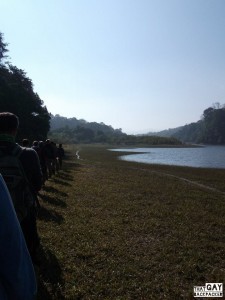
And the trekking begins…
I was really gagging to see an elephant out there in the park because I had never seen an elephant in its natural habitat before, but the owner of the guesthouse where I was staying lowered my expectations and told me that people rarely see them. Less than an hour into the trek and I didn’t just see an elephant, I saw a whole bunch of them, including babies. It was *the* most heart filling thing. I have seen elephants in zoos before, but to see them in this environment just being together and getting on with their lives gave me a very different feeling, and it was something that I was quite unprepared for. Alas, I didn’t get to see any of the tigers in the park, but even seeing their claw marks against the tree bark throughout the jungle gave me shivers. I can be guilty of getting absorbed in my own little world, and this experience in Periyar Tiger Reserve totally took me out of myself and made me feel the sheer scale of the world and all of the variety that it inhabits. A definite positive about travel for me has been how small these kinds of experiences can make you feel – there is nothing like watching a mother elephant feeding her baby in the wild to make you stop worrying about what the humidity is doing to your hair.
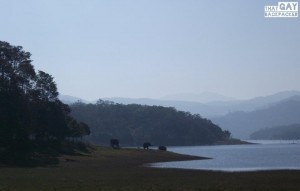
Those blobs are elephants. Pinkie promise.
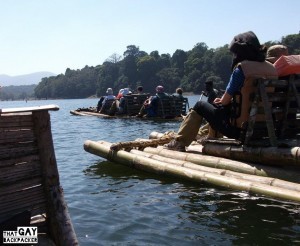
A spot of rafting…
And even if you don’t get to see an elephant or a tiger, the area is so beautiful that the trip will be well worth your money and time regardless. I recall first setting my eyes on the gargantuan lake for the first time and inhaling deeply at the sheer enormity of it. While rafting through this beautiful area I felt a complete sense of calm, and as one of life’s worriers that’s not something that happens to me very often. I guess it’s just a little difficult to feel stressed out when the landscape of Periyar unfurls in front of you.
In summary: Periyar Tiger Reserve, elephants, monkeys, tigers, rafting, heart filling, GO THERE.
The post Periyar Tiger Reserve: Exploring Kerala’s Jungle appeared first on We Said Go Travel.
Australia: Heading West – Windorah Bound
We left the Sunshine Coast at 3:30 AM with the headlights of the truck slicing through the thick fog and darkness engulfing the highway. Our destination was the little town of Windorah in western Queensland, nearly in the heart of the continent. Actually, we were headed to the bushland that laid over 50 kilometers to the west of town. Our goal was to find two of Australia’s iconic reptilian fauna: the Perentie, Australia’s largest lizard, and the Inland Taipan, the world’s most venomous snake.
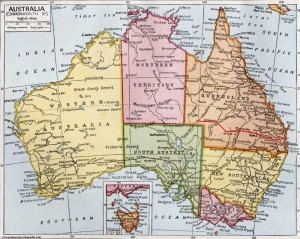
There were three habitats we would encounter on our trip, huge red sand dunes dotted with silvery spinifex grasses, treeless plains with cracked earth and towering escarpments littered with caves and boulders. Each habitat contained animals perfectly adapted to dealing with the harsh and arid climate of central Australia. The trip organizer was a good friend I had worked with at Australia Zoo, Lockie, whose insurmountable knowledge of Australian fauna painted a bleak interior full of life.
As the habitats outside the windshield changed from lush coastal forests, rich in hills and endless fields of grass to flat red dirt scattered with sparse and bushy Mulga trees I became more enthralled with the natural world of Australia. Nowhere else on the planet had species so unique and perfectly adapted to a variety of habitats as Australia; it was the land of reptiles and marsupials, parrots and finches, ghost gums and spinifex.
Emus, goofy looking birds that stand as tall as a man, pecked aimlessly on the roadside in surprising numbers. Their thick black legs occasionally kicked up clouds of red dust as they ran off, startled by the sound of our ute pounding along. Spinifex scrubland dotted with Mulga trees harbored mobs of kangaroos and the roadside showed the fateful results of their nightly escapades. Long white bones, skulls wearing ghastly smiles and Crows, Wedge-tailed Eagles and Black Kites feeding on the unfortunate fresh macropodian specimens took up vast stretches of the red-hilled roads.
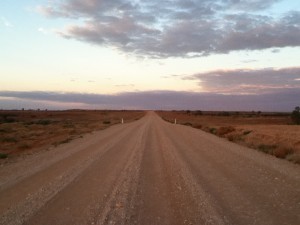 Unfenced cattle ranges that reached out to the distant horizon were dotted with knee-high spinifex grass and the steel cattle grids that stretched along the small highway rumbled heavily as Lockie continued the drive.
Unfenced cattle ranges that reached out to the distant horizon were dotted with knee-high spinifex grass and the steel cattle grids that stretched along the small highway rumbled heavily as Lockie continued the drive.
Two dancing silhouettes in a field moved slowly along the road’s edge. A pair of Brolgas were searching for their evening meals as the sun sank in the sky. Their red crowned heads kept a wary eye on us as we slowed and their long bills proceeded with their persistent search for food between the grass tussocks. We continued on into the dark night in the Australian outback; the stars slowly emerged like diamonds on a velvety black sky. With no light pollution one could see almost every band in the Milky Way. The headlights made the Mulga trees eerily silver as their branches swayed in the evening breeze.
Feral cats fed on the carcasses of unfortunate kangaroos and emus, their eye shine reflected brightly from the darkness. The cats were wreaking havoc on the Australian environment, consuming indigenous animals at extraordinarily high levels and reproducing at even higher numbers. They, along with feral pigs, goats and dogs, put excessive strain on fragile ecosystems across the continent.
After many more hours on the road, we finally made it to the caravan park in Windorah. We unrolled our swags and fell into a deep sleep under a blanket of stars. The next morning we awoke to bickering of the Apostle Birds on a nearby tree.
Windorah looked like a quintessential western town, with dust being carried down the main road on a warm breeze. There were a few houses and even fewer business, two gas stations, no traffic lights or stop signs, and, if you stood in the right spot in the town center, you could see its beginning and end. The day was already warming so we quickly packed up camp and headed out into the bush, stopping near a series of massive escarpments after a lengthy drive.
The red land stretched out before us interrupted only by more escarpments in the distance. The cliff faces rose high off the flat ground and were dotted with caves and cracks. Boulders were scattered about their bases and unstable red rocks about the size of a fist lined the steep inclines leading to the precipices.
We began our search in earnest for a Perentie, delving into every cave, searching every crack, following every trail. They inhabit a variety of habitats in the arid regions of Australia from western Queensland all the way to the coast of Western Australia and a few islands in the Atlantic. I had worked with a few Perenties at Australia Zoo and knew their habits, but to see where they come from helps one to understand their importance in the wild and can light passion to conserve such a beautiful creature.
Fresh slides from a large Perentie could be seen in a few places and we even located fecal samples from the giant monitor, including one that contained the claws from a feral cat and another that contained the remnants of another lizard resident of the area: the Central Bearded Dragon.
Click here to read more from Hunter including the rest of this series.
The post Australia: Heading West – Windorah Bound appeared first on We Said Go Travel.
Winners: Independence Travel Writing Contest
Thank you to all our writers from our 2013 Independence Travel Writing Contest!
One hundred and eighty-eight writers from thirty-one countries participated to write about seventy-three countries for our contest!
The writers are from Australia, Austria, Canada, France, Germany, Greece, Hungary, India, Indonesia, Ireland, Israel, Italy, Kenya, Netherlands, New Zealand, Nigeria, Pakistan, Philippines, Portugal, Republic of Moldova, Romania, Singapore, Slovakia, South Africa, Sri Lanka, Sweden, Uganda, UK, Ukraine, USA, Vietnam.
Click here to read all the entries.
AND THE WINNERS ARE:
Our First Place Winner is Jillian Gotfredson who was born in South Korea but grew up in Kansas City, Missouri. Enjoy her article, “Myanmar, Ferry Mothers.”
Our Second Place Winner is CC Xander who is one of America’s elite tennis coaches and travelers. Enjoy his article, “Tulum, Mexico.”
Our Third Place Winner is Esther K. Meyers who born in a DP camp at the close of the war to holocaust survivor parents. Enjoy her article , “Poland: The Magic of Discovering Legacy.”
Honorable Mention:
Fatimah Abdulmalik “Shackles Released in Sudan“
Chris Palmer: “Tanzania: Freedom in Motion”
Asia and Russell Nichols: “Indonesia: Wooden Pole in the Village“
Congratulations to our winners! Thank you to everyone who participated!
We especially thank our esteemed judges: Richard Bangs and Amy Friedman.
We really appreciate everyone who shared, tweeted, promoted and participated in our Independence Travel Writing Contest.
We hope you will join in our Gratitude Travel Writing Contest with $1,000usd in cash prizes; enter from September 11 until November 28, 2013.
We look forward to reading more of your stories in our next contest! Credly Badges will be arriving soon for all writers and winners!
Happy and Safe Travels.
The post Winners: Independence Travel Writing Contest appeared first on We Said Go Travel.
September 2, 2013
Myanmar: Biking Inle Lake (video)
WATCH: 37 Biking Inle Lake Myanmar (Burma)
Our first stop was to figure out our transportation back to Mandalay. We met friendly five year-old Mimi. On the road, we saw a group practicing their leg rowing. The ride was beautiful—we saw red lotus flowers, fields and many animals. The road was not so good so everyone went slowly. I liked that.
After visiting the Thupin resort, we took a boat across. EIGHT of us with EIGHT bikes in one BOAT! It was a bit crowded but memorable. We ate lunch with Claire and Bruno from France. Together we visited the monastery—a true cacophony of voices. The best part of the local Red Mountain Estate winery was the view from the top of the hill. When we returned to town, they had built a platform next to our hotel for the upcoming ceremony. We ate dinner at Everest restaurant. We are planning to go to Nepal later in our journey. Will I be a good trekker? I am a much better biker now! Maybe I will be a good trekker. We ate Dal Baat and talked about our plans for the future.
This movie is from our 28 days in Myanmar (Burma) from September 28, 2012 to October 26, 2012 and our year TRIP in South East Asia, see all the videos from our trip. October 21, 2012
Our memoir, Traveling in Sin, is available at Amazon; it is a HOT NEW RELEASE!
Traveling in Sin is a HOT NEW Release on Amazon! from Lisa Niver Rajna
Traveling in Sin is a true tale of TRANSFORMATION thought LOVE and TRAVEL! After meeting online (on two different sites), George and Lisa travel internationally, give up their jobs, condo, ice cream and toilet paper in search of adventure and love. Along the way, Lisa sheds over 60 pounds and the couple gets engaged underwater in Thailand. There are tears, twists and true love!
Recent Press:
By Amy Sommer on Westside Today
By Dani Stone on Diets in Review
The post Myanmar: Biking Inle Lake (video) appeared first on We Said Go Travel.
They Said Isola Bella, Italy: Reflections About How Travel Brings You Home
My husband and I were finally able to indulge in that long-awaited sojourn to Italy this past summer. One of the most captivating places we were fortunate enough to visit was Isola Bella, an island located in Lago Maggiore in the resort district of Northern Italy. Isola Bella is renowned for its historic baroque palace and adjoining formal gardens which have belonged to the famous Borromeo family since the 1600s. In fact, Charles Borromeo named Isola Bella, which means “beautiful island,” in honor of his wife, Isabella. Today the Borromeo family maintains their major residence in Milan, but they do spend a few weeks on Isola Bella every summer.
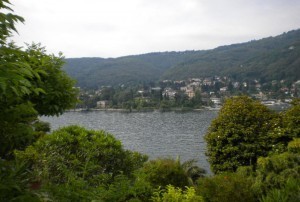
View of Lago Maggiore and surrounding mountains from the island of Isola Bella in northern Italy.
The palace boasts historic significance. One of the rooms was the site of the 1935 Stresa Conference in which Italian dictator Benito Mussolini met with British and French diplomats in their united attempt to intimidate Germany out of launching World War II. The endeavor failed when Mussolini double-crossed his fellow diplomats, attacking Ethiopia and joining forces with Hitler. Napoleon Bonaparte and his wife Josephine add another historic dimension to Isola Bella. They were once guests at the palace during the French emperor’s reign. In fact, tourists can visit Napoleon’s bedroom, which purportedly contains the very bed in which the imperial couple slept. Unfortunately, the bed is the only piece of furniture in the vast, vacant, echoing bedroom space. Just about the only other feature of the room is a picture window which, although relatively insignificant by itself, draws the eye to a spectacular view of the glistening lake below and the verdant Italian mountainsides in the distance.
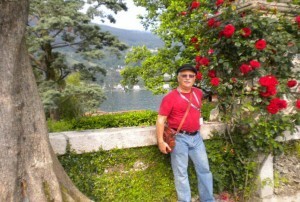
Hal enjoys the beautifully landscaped gardens of the Borromeo palace on Isola Bella.
Which brings me to an observation. Despite the owners’ annual pilgrimage to their impressive palace on their picturesque island, the house does not feel at all like a home. Its stone walls and floors and sparsely furnished rooms do not convey the slightest feeling of hospitality or comfort. The tourist wanders from one cold, empty, echoing space to the next throughout the structure. Why invite the public in to view an interior so uninviting? I can only speculate on the Borromeos’ reasons, but the visit generates in me the hope that our own home, although not nearly so
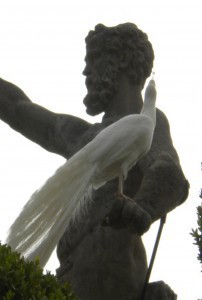
Exotic white Chinese peacocks inhabit the gardens of Isola Bella.
palatial, is at least a place of warmth and comfort to those who visit us. Every home, even if sparsely furnished, should convey convivial intentions. And while we’re meditating on lessons learned, let’s hope that the family history created in our homes is more noble than that of a duplicitous Italian dictator.
The tour of the palace eventually leads the visitor to expansive and magnificent formal gardens. The well-manicured lawns, meticulously pruned shrubs, and intricately-designed hedge patterns are truly a delight. And the profusion of brilliant flowers—not to mention the very exotic Chinese white peacocks—dazzle the eye. It’s all so precise, so controlled. But then, baroque is all about controlling nature, isn’t it? But what a contradiction, to find so much strict design embedded squarely in the middle of the abundant natural beauty of the crystal blue lake and the uncultivated mountains. But, I reflect, isn’t that the very purpose of every man’s castle? To provide an island of our own preferred construction and arrangement, where we can take refuge from the sometimes uncivilized environment that surrounds us? Lastly, I feel compelled to add a comment about the copious statuary erected throughout the gardens. Too many statues! Flora, whether growing naturally or by controlled design will always create a comforting sense of serenity. This is true whether the greenery consists of a few potted plants on an urban patio or expansive lawns and gardens. Too many man-made objects, on the other hand, create a discordant sense of clutter. I carried away from the gardens on Isola Bella a resolve to make my own modest little estate as attractive as possible, but to avoid imposing an order so strict or so cluttered that it negates the natural beauty of the surroundings.

The expansive gardens of Isola Bella are impressive, but there are too many statues!
I apologize if it appears I am too critical about a place that truly is so charming. But I would assert that travel is supposed to enlarge and enlighten. My sojourn to the palace and gardens of Isola Bella has certainly enlarged my personal perspective on the essence and substance of home. Because, perhaps, we might all agree that, east or west, home is best!
The post They Said Isola Bella, Italy: Reflections About How Travel Brings You Home appeared first on We Said Go Travel.
We Said Go Travel
We Said Go Travel is a global community of over sixteen hundred writers with articles from every continent.
Stories are shared with photos and video from a perspective of the transformative power of travel. We Said Go Travel has hosted live and online events as well as travel writing contests around the world. ...more
- Lisa Niver's profile
- 57 followers


